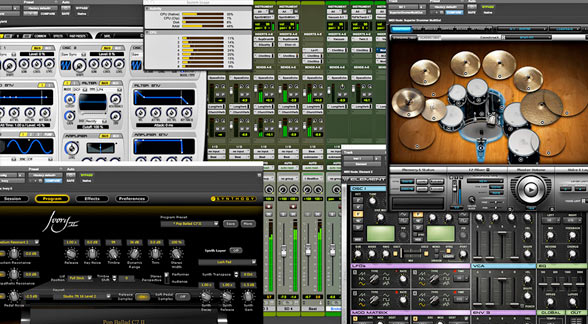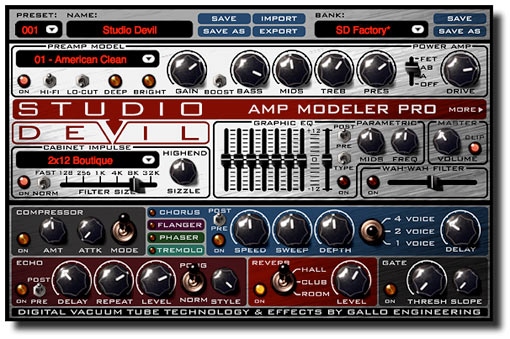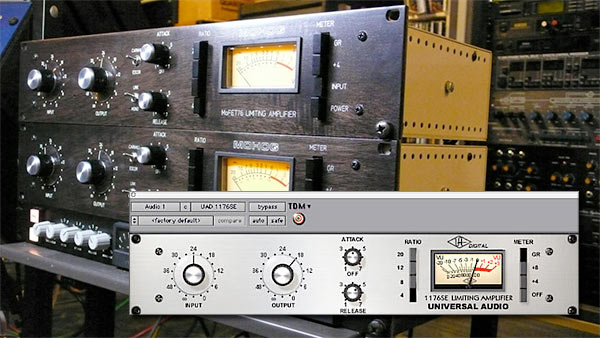Plug Me In
The way most commercial recordings are made today is not that different than the way that we made them in the 60s through 90s. Recording studios and engineers would use multitrack recorders to successively capture the rhythm instruments (and possibly scratch vocals) followed by a number of overdubbing sessions. Once all of the instrumental and vocal parts were just as the artist and producer wanted, the tracks would be mixed down into a stereo rendition.
Signal processors were used during each step in the process. During the tracking sessions, engineers would capture tracks using compressors to create specific tonal characteristics AND to protect the track from distortion. Noise gates (the infamous Kepex) would remove the obnoxious crap that came through pedal boards and other electronic equipment. These processors would be recorded on the tracks because they were part of the “sound” that the producers and engineers wanted.
Other signal processors like the ubiquitous digital reverbs run all the time but are not locked onto tape until the very final mixdown. You can always add reverb but it’s virtually impossible to remove it later. These processors were individual pieces of equipment that populated an “outboard” rack and were looped into the signal flow using patch cords and a patch bay (a series of holes that represent the inputs and outputs of every piece of gear in the studio).
Things changed when PCM digital system began to dominate music production. The general process these days is very similar to forty years ago but the equipment and capabilities of that equipment have dramatically changed. We struggled to get 8 then 16 then 24 tracks on the ever wider analog tapes. The standard became a 2-inch 24-track machine. As a joke, I once saw an 8-inch high reel of tape at an AES event…thankfully we never got there. It must have weighed 25 pounds.
Nowadays, Pro Tools and other digital audio workstations can easily accommodate 60-100 tracks (remember Sgt. Peppers was produced on a 4-track deck)! The final mixes that are done at places like the Warner Brother rooms I visited last week routinely have 150 plus tracks…and consoles with at least that many inputs. To be accurate, sometimes a track contains only a single gunshot or horn stab…but the idea of limiting the number of tracks is a thing of the past (at least if you stay in the standard definition sample rate range…meaning 48 kHz). Moving to 96 kHz means the digital processors have to struggle with the added data. Some engineers are now recording at 96 kHz and even 192 but not many.
So has there been an attendant increase in the size of the outboard rack? Do engineers have to have dozens of individual signal processors to serve the large number of tracks? Not really. Teams of clever DSP engineers figured out that they could “model” the characteristics of any piece of analog or digital electronics in software. Thus the world of digital plug-ins was born.
Figure 1 – An amplifier modeling plug-in for Pro Tools.
One of my first experiences with modeling came when I purchased a Spider guitar amplifier by Line 6. Rather than get one sound from a Fender or Musicman amp, I got an “acoustic modeling” amp that allows you to switch from a variety of amp types. My wife loved the heavy grunge Marshall sound!
These days if you want to use an Orban parametric EQ or UREI 1176 compressor/limiter on a particular track, all you have to do is have the right add-on software plug-in and presto…your track is routed through a software processor that emulates the real thing. The patching is done “in the box”. There is no need for a physical patch bay or the physical processor. Hardware makers had to find new ways to sell their boxes.
Figure 2 – An analog 1176 compressor/limiter and a plug-in version
The world of plug-ins includes emulators for existing “classic” pieces of gear AND processors that can only be implemented in software. Designers of these software signal processors sell them to studios that have the host Pro Tools rigs to support them. And they aren’t cheap. As I said yesterday, I have many thousands of dollars worth of software licenses for my existing PT rig to support my film mixing clients. They require a digital locking mechanism that must be attached to the CPU via a USB stick.
So track counts have risen, the use of processors has dramatically increased (think vocal processors especially) and the thick music layering that is all the rage. But has the sound of the music improved? I’ll let you decide.




This is a very interesting looking out how far technology has come and how it is being used. Like you mentioned that Sgt. Peppers was produced on a 4- track deck, and now stupid little college kids (speaking of myself) have access to quadruple the amount of capabilities to record and mix music. But you don’t see any college kid producing a song like “A Day in the Life”.
Were you saying that standard definition sample rate was 48k? So is 44.1 now below standard? And another question that I believe is important when talking about the evolution of digital plug ins, is there performance. Is there really any difference in the in performance with a physical UREI 1176 compared to the plug in version? If there weren’t, what would be the point of ever needing a physical one? These are just some thoughts.
Good stuff Dr. Waldrep
I agree Ken, you don’t see us college kids coming up with the next great sgt peppers album… but there are some musicians out there doing some really great stuff who wouldn’t otherwise have access to the equipment. I think of Misha “bulb” Mansoor from the band “Periphery” who might never have been discovered if it wasn’t for his spectacular self produced recordings he posted on soundclick.com. Skrillex is also amazing, the kid might be an electronic musician and a lot of people hate on what he does but I am telling you he is a musical genious. Point is there will prabably never be albums as loved as the Beatles’ albums, but my hope is that with easy access to quality recording tools and equipment the great albums will be exceptional because they will have to be in able to rise above the rest. They can no longer just sound great… they have to be great.
Has the sound of music “improved” with processing? I would say yes for the most part. As long as we can agree that a great album is a great album even if it is a lower quality, I.E. Sgt. Peppers. What’s really great is the democratization of the music production studio in general. In the past if one wanted access to an 1176 compressor, or other great outboard gear, one would have to shell out tons of money for either studio time or the hardware unit itself. Yes, audio plugins are expensive but not nearly as expensive as buying all of that physical outboard gear outright. Now as long as one has a few thousand dollars one can literally have access to hundreds of great plugins to improve their sound. One does not need to be signed to a major label in order to make quality recordings. There is also the issue of trusting that the modeling of the plugin is accurate to the hardware unit. Being an enthusiast of amp modeling in particular I believe that the software version of outboard gear has vastly improved in the last 5 years and in a lot of cases actually sounds better than analog hardware. On top of that there is a lot MORE one can do with a piece of software instead of hardware. For example, plugin automation, or having a hundred instances of a certain compressor. Also… I would loved to have seen an 8 Inch reel of tape.
I’ve always admired how the older generation of audio recording engineers have managed to make a full band recording fit into 8-16 track analog tapes. Trying to learn about how it was done back then can be very overwhelming because I myself have never used or experimented with it. The recording of that time seemed like it was a very precise art that left no room for mess ups, otherwise you’d be spending a lot more money trying to record the song than making a profit. Being in this newer generation, it’s easy to just use a plug in to make a certain track sound professional. One doesn’t need to be an audio recording genius to necessarily understand signal flow, but can play around with the plugins with in a DAW and find the sound they are looking for. The only flaw with the digital plugins is that it doesn’t sound the same as if you were using outboard gear. Like you said that the patching is done “in the BOX” and unfortunately that what a song sounds like when it’s mixed within the software. It sounds like its in a box. Anywho this was a good reading and always enjoy to hear your thoughts.
Thanks Dr. Waldrep